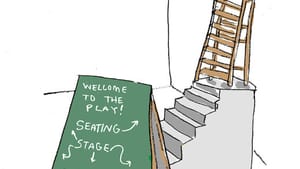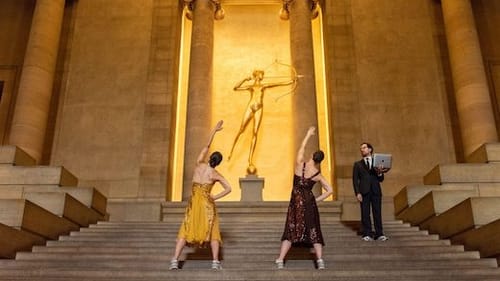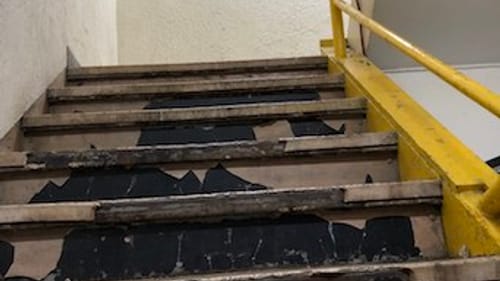Stay in the Loop
BSR publishes on a weekly schedule, with an email newsletter every Wednesday and Thursday morning. There’s no paywall, and subscribing is always free.
On the Fringe's fringe
Disability and the Fringe Festival: Increasing access

At a Fringe show in Kensington, I arrived in the garden about 15 minutes before showtime and glanced at the seating area, where it looked like a group of people on their feet were gathering. More people than chairs.
“What’s the seating situation?” I asked the woman handling tickets. She was apparently one of two people working the box office and house, and they looked overwhelmed.
“The chairs are over there,” she gestured. “You can have a seat.” And she turned to the people in line behind me.
But it looked like the company had sold more tickets than they had seats at the outdoor venue, and during the performance the audience moved three separate times, staying on their feet to watch the actors.
I emailed one of the founding artists before attending. He said I could stay seated throughout the performance if needed — without mentioning that there might not be enough seats and that if I stayed in one, I would miss at least half the show.
Festival of pain
I’ve been covering the Philly Fringe for about 10 years, and I’m finally being honest about how hard it is for me. It’s not just the hectic schedule of lots of shows and organizing all that coverage. The festival is physically grueling.
Most of the shows I saw this year would not have been accessible to anyone who couldn’t climb a flight of stairs; sit in a small, rickety wooden or metal folding chair; or move easily around a building or outdoor area with uneven surfaces. All of these things are difficult for me, even on a good day.
On a bad day, I just have to cancel my tickets. As usual, I skipped many shows altogether (though I was interested) because I knew I couldn’t stay on my feet for the duration of the performance or participate in a show’s physical demands.
Beyond wheelchairs
It’s great that theatermakers push their art outside traditional structures, figuratively and literally. But especially in a festival where lots of work focuses on the experiences of marginalized people, we must recognize that many of these shows are happening in venues or formats that exclude people with disabilities.
I don’t use a wheelchair, so why do I care? Besides the principle, wheelchairs aren’t the whole picture. Did you know that only about 27 percent of the 56.7 million people with disabilities living in the United States (according to the 2010 Census) use an assistive device such as a wheelchair, cane, crutches, or walker?
Disabilities can include difficulty seeing or hearing or having your speech understood, difficulty walking, cerebral palsy, dyslexia, depression, and more. For close to 75 percent of people with a disability, there might be no obvious outward sign.

You see me only on my good days, so you might not know that I live with multiple chronic illnesses that sap my energy and cause severe pain. If you’re an able-bodied person, imagine walking up to the box office and realizing that to attend the show, you must scale a 20-foot wall bare-handed and then balance at the top for an hour or more — and everyone around you is doing it just fine.
That’s how it feels sometimes to me, when I have to climb several flights of stairs to see a show that may not even offer seating (the common Fringetime phrase “the audience moves throughout the space” fills me with dread).
The gap at the box office
I get that it’s tough in Philly. Buildings are narrow and tall and historic. It’s expensive to update them with ramps and elevators. And it’s tough for independent artists. They probably can’t afford the kind of ADA-accessible space you’ll see at venues like the Kimmel Center, which may also offer occasional accommodations such as sensory-friendly performances, assistive listening devices, audio description, or ASL interpretation.
So, we’re in a tragic gap. The Philly Fringe, which is highly accessible in many ways, including low ticket prices and environments inclusive of many marginalized people, is also often closed to people with disabilities. And it’s not just because of the spaces’ limited amenities; bare-bones staffing can leave little attention for patrons who need extra help.
Not a niche
Disability can affect anyone. Consider those with a broken leg, pregnancy, elderly people with limited mobility, adults with children in strollers. When your venue is not ADA accessible, you may be excluding these folks as well.

No one today would mount a show and stipulate that only white people can attend. But we’re apparently fine with having a show up three flights of stairs without acknowledging that people who can’t climb stairs won’t be able to come. There’s no justice in that, no matter what your show is about.
As local accessibility consultant and advocate Elizabeth Clay says, “People with disabilities are not a niche audience.” (For tips on accessible arts experiences in the greater Philadelphia area, check out her Instagram, @accessibleartphila.)
People with disabilities have the same interests and should have the same rights as everyone else. From the Walnut’s Holiday Inn to Lee Minora’s White Feminist, there’s no reason to think we won’t be among your ticket-buyers — if we can get in the door.
What we can do now
I realize things won’t change overnight. Unless I miraculously get a new body, simply attending the Fringe Festival in my job as an arts journalist will always push my physical limits. At the Kensington show, I ended up perching on a low concrete wall, standing when I had to, and then working from bed the following day as I tried to recover.
But we can still promote the conversation around accessibility. Clay is right: people with disabilities are not a niche audience, and at BSR, they’re not niche readers, either. When I cover an arts event, you (the reader) deserve to know up front whether it’s accessible to you and your friends and family.
So look out for a new standard in our arts coverage, where we note whether a venue is ADA accessible or whether it offers other accommodations such as sensory-friendly shows, audio description, or ASL interpreters. Maybe paying more attention to these questions in our publication will boost accessibility awareness, among audiences and the artists and institutions that serve them.
Sign up for our newsletter
All of the week's new articles, all in one place. Sign up for the free weekly BSR newsletters, and don't miss a conversation.

 Alaina Johns
Alaina Johns
 Illustration by Hannah Kaplan
Illustration by Hannah Kaplan